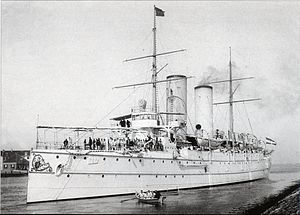Holland-class cruiser
This article needs additional citations for verification. (January 2013) |
 HNLMS Noordbrabant
| |
| Class overview | |
|---|---|
| Name | Holland class |
| Builders |
|
| Operators | |
| Preceded by | Koningin Wilhelmina der Nederlanden |
| Succeeded by | Java class |
| Built | 1895–1901 |
| In commission | 1898–1944 |
| Completed | 6 |
| Lost | 1 |
| Retired | 5 |
| General characteristics | |
| Type | Protected cruiser |
| Displacement |
|
| Length |
|
| Beam | 14.8 m (48 ft 7 in) |
| Draught | 5.41 m (17 ft 9 in) |
| Propulsion | 10,000 ihp (7,500 kW), two shafts |
| Speed | 20 knots (37 km/h) |
| Complement | 324 |
| Armament |
|
| Armour | 5 cm (2.0 in) deck |
The Holland class was a class of six protected cruisers[a] of the Royal Netherlands Navy. The class was built in two groups, each consisting of three ships.
Design[edit]
The design was based on the British Apollo-class cruiser, although it featured the more seaworthy form amidships of the Astraea class.[1] The first three ships of the class were 93.3 metres (306 ft 1 in) long while the last three were 94.7 metres (310 ft 8 in) long, had a beam of 14.8 metres (48 ft 7 in), a draught of 5.41 metres (17 ft 9 in), and had a displacement of 3,900 tons. The last three ships were slightly larger and displaced 133 tons more than the first three ships.[2] The ships were equipped with two shaft reciprocating engines, which were rated at 10,000 ihp (7,500 kW) and produced a top speed of 20 knots (37 km/h). The ships had 5-centimetre (2.0 in) deck armour. The main armament of the ships were two 5.9 in (15 cm) single guns. Secondary armament included six single 4.7 in (12 cm) guns and four 3 in (7.6 cm) single guns. In 1914-1915 refits, the 5.9 in guns were removed from each ship and replaced with an additional four 4.7 in single mounts.
Construction[edit]
The class was built in two groups each consisting of three ships. The ships were laid down at Rijkswerf in Amsterdam, Koninklijke Maatschappij de Schelde in Flushing and Nederlandsche Stoomboot Maatschappij in Rotterdam.
| Name | Laid down | Launched | Commissioned | Decommissioned | Builder | |
|---|---|---|---|---|---|---|
| First group | ||||||
| Holland | 1895 | 4 October 1896 | 1 July 1898 | 1920 | Rijkswerf, Amsterdam | |
| Zeeland | 1895 | 20 March 1897 | 1 June 1898 | 1924 | Koninklijke Maatschappij de Schelde, Flushing | |
| Friesland | 1895 | 4 November 1896 | 16 January 1898 | 1913 | Nederlandsche Stoomboot Maatschappij, Rotterdam | |
| Second group | ||||||
| Gelderland | 1 November 1897 | 28 September 1898 | 15 July 1900 | 17 May 1940 | Nederlandsche Stoomboot Maatschappij, Rotterdam | |
| Noordbrabant | 31 August 1897 | 17 January 1899 | 1 March 1900 | 17 May 1940 | Koninklijke Maatschappij de Schelde, Flushing | |
| Utrecht | 1897 | 14 July 1898 | 1 March 1901 | 1913 | Rijkswerf, Amsterdam | |
Service history[edit]
On 19 October 1900 Gelderland transported Paul Kruger to Europe during the Second Boer War. Holland together with Koningin Wilhelmina der Nederlanden and the Evertsen-class coastal defence ship Piet Hein were sent to Shanghai to defend Dutch interests during the Boxer Rebellion. Holland and Zeeland together with the coastal defence ships Hertog Hendrik, Koningin Regentes and De Ruyter assisted the KNIL during the Aceh War. In 1908 Friesland, Gelderland and the coastal defence ship Jacob Van Heemskerck were sent to patrol the Venezuelan coast during the second Castro crisis. Friesland and Utrecht were decommissioned in 1913 with the remaining four being modernized. During World War I all remaining ships were stationed in Dutch home waters. Holland and Zeeland were decommissioned in 1920 and 1924 while Noordbrabant became an accommodation ship in 1920. A role she fulfilled until she was damaged during the German invasion in World War II. Gelderland became a training ship in 1920. She was captured by Germany in 1940, renamed Niobe and sunk during the war in Kotka harbour in Finland on 16 July 1944.
Notes[edit]
- ^ In the Dutch navy the ships where classified as "pantserdekschepen" literally translated: armored deck ships.
References[edit]
Bibliography[edit]
- Johnson, Harold & Marshall, Peter A. (2015). "Question 9/51: Dutch Cruiser Gelderland". Warship International. LII (1): 79–81. ISSN 0043-0374.
